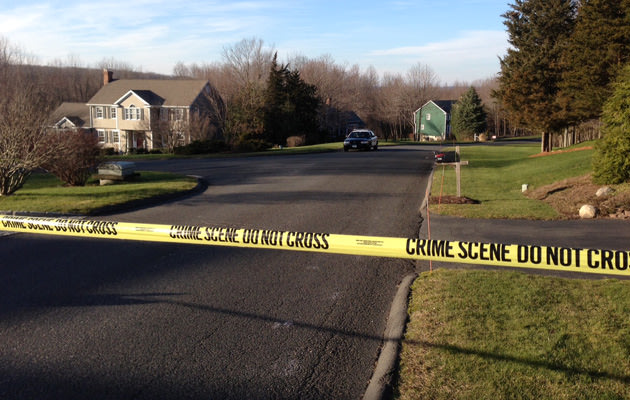 Police prohibited access on Saturday to the neighborhood where gunman Adam Lanza lived. (Jason Sickles/Yahoo N …
Police prohibited access on Saturday to the neighborhood where gunman Adam Lanza lived. (Jason Sickles/Yahoo N …
NEWTOWN, CONN. -- Even to his neighbors, the gunman who massacred 26 kids and educators at an elementary school here still remains somewhat of a mystery.
"I want to know more," said Len Strocchia, who lives less than half mile away from the shooter's house.
Authorities say Adam Lanza, 20, killed his mother, Nancy Lanza, at their well-to-do home Friday morning before driving to Sandy Hook Elementary where he stormed in and committed one of the worst mass school shootings in U.S. history. The victims were 20 first-graders and six staffers, including the principal.
Adam Lanza's parents divorced a few years ago. Messages left with his father, Peter Lanza, were not returned.
On Saturday, Strocchia walked down the street to see the shooter's house firsthand, but was forbidden to go past a police barricade near the Lanza home.
"I want to know which house and why I didn't know them," the father of two teenagers told Yahoo News.
Another neighbor did know Adam Lanza. Megan, who declined to give her last name, was a classmate of the shooter from kindergarten through middle school.
"He wasn't like a weird kid as a child," Megan told Yahoo News. "He was just quiet. He didn't put off a friendly vibe."
But she said he was one of the smartest students in school.
"He was always participating in class and everything," Megan said.
But she said her former classmate with whom she rode the school bus sort of vanished after their junior high years.
"He almost fell off the radar in middle school," Megan told Yahoo News.
The shooter's aunt, Marsha Lanza, told ABC News that his mother pulled him out of Newtown public schools because of a dispute over the district's plan for her son.
"She mentioned she wound up home-schooling him because she battled with the school district," the aunt told ABC News.
Police said Adam Lanza, dressed in all black, was armed with two handguns and a semi-automatic Bushmaster .223 rifle when he barged into the school.
Dr. Carver, the medical examiner, said it appears that all the children where gunned down by the military-style rifle. Authorities said all the weapons were legally owned and registered by Nancy Lanza, the shooter's mother.
Newtown school superintendent Janet Robinson told reporters Saturday that Nancy Lanza had no connection to Sandy Hook school, despite initial reports Lanza was on the faculty or a substitute teacher there.
"I'm sickened that this mass murder was done with legal guns," said Strocchia, the neighbor. "I'd like to find out why. Why did she have guns?"
But acquaintances of Nancy Lanza told The New York Times that the 52-year-old mother was a big fan of guns.
"She had several different guns," Dan Holmes told the newspaper. "I don't know how many. She would go target shooting with her kids."
Reports that Adam Lanza may have suffered from a personality disorder are being supported by people who knew the mother to have a troubled son.
According to the Times story, a friend said Nancy Lanza was "handling a very difficult situation with uncommon grace."
Investigators revealed on Saturday that evidence found in the Lanza might provide a possible motive for the massacre.
State police spokesman Lt. Paul Vance declined to provide specifics about the evidence but said, "we're hopeful it will paint a complete picture."
Neighbors like Strocchia are searching for answers too. However, he said, said he harbors no anger.
"I'm thankful my children are alive," he said. "I have compassion and mercy. There was something wrong with him."










